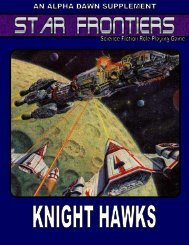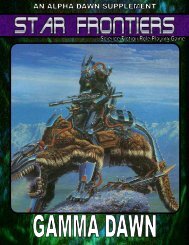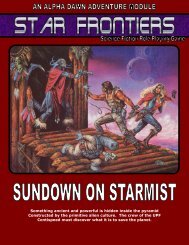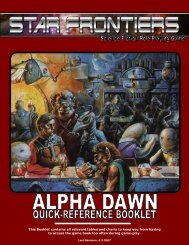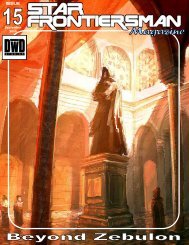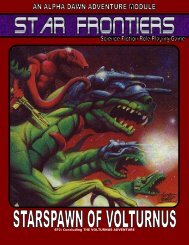Alpha Dawn - Star Frontiersman
Alpha Dawn - Star Frontiersman
Alpha Dawn - Star Frontiersman
Create successful ePaper yourself
Turn your PDF publications into a flip-book with our unique Google optimized e-Paper software.
discourage attackers or protect the creature from<br />
damage, and are often adapted to the terrain the<br />
creature lives in. Some examples are bounding away<br />
from attackers, natural camouflage, a thick hide or a<br />
protective shell.<br />
9<br />
Does It Have Any Special Abilities?<br />
The referee must decide if the creature has any<br />
special abilities or adaptations to the terrain,<br />
and their effects in the game. Some examples of<br />
special abilities are glowing in the dark, spinning webs,<br />
making honey, building crude bridges or homes,<br />
changing color or shape, etc. Special adaptations<br />
include fur to keep warm in winter, fins to keep cool in<br />
the desert, etc. Special abilities make creatures<br />
interesting and alien, but referees should not make<br />
them too common or players will come to expect them.<br />
10<br />
What Does the Creature Look Like?<br />
The referee should decide what the<br />
creature looks like. The answers to the<br />
earlier questions will help determine the creature's<br />
appearance.<br />
Creating Creatures (Summary)<br />
1. What is the purpose of the creature in the<br />
adventure?<br />
2. What type of creature is it?<br />
3. How large is the creature?<br />
4. How many of these creatures are usually found<br />
together?<br />
5. How fast is the creature?<br />
6. What are the creature's ability scores?<br />
7. How does the creature attack?<br />
8. How does the creature defend itself?<br />
9. Does the creature have any special abilities?<br />
10. What does the creature look like?<br />
Creature Reactions<br />
A creature's reaction to a character depends on the<br />
creature's temperament and what the character<br />
does. The creature may be naturally timid, curious<br />
or aggressive; it may be hungry, or it might have<br />
just eaten. A character can affect the creature's<br />
reaction by ignoring it, coaxing it with food, or<br />
frightening it with fire, loud noises or flashes of<br />
light. The referee must use his judgment in these<br />
cases, but several things to consider are outlined<br />
below.<br />
• Intelligence. Intelligent creatures will not be frightened<br />
by a burning torch, clanging frying pans, etc. Creatures<br />
with low intelligence, however, might be easily startled<br />
or frightened away by these actions.<br />
• Experience. A creature is less likely to be afraid of<br />
something it has seen before, unless the previous<br />
experience was very painful or frightening.<br />
• Size. Large creatures often are harder to frighten then<br />
small ones.<br />
• Type. Carnivores tend to be more aggressive and<br />
harder to frighten than herbivores, which tend to be<br />
timid. Omnivores tend to be curious.<br />
• Temperament. If a creature is naturally aggressive, it<br />
may attack creatures much larger than itself with very<br />
little fear. Timid creatures try to avoid fighting whenever<br />
they can.<br />
• Motivation. Any creature that fights has a reason for<br />
fighting. Even naturally shy and weak creatures may<br />
fight savagely to defend their lair, their territory or their<br />
young. Creatures that are cornered or wounded, sensing<br />
that they must fight or die, often fight ferociously and<br />
without fear.<br />
Creature Description Blocks<br />
After a referee designs a creature, he should write<br />
the information about it in a standard format. The<br />
sample creatures show one possibility.<br />
Average Creatures<br />
Average values and ranges for each of the standard<br />
creature types are listed below. The referee can use<br />
these tables when he needs a new creature quickly.<br />
The scores can be used as they are listed, or<br />
modified to produce creatures with above or below<br />
average statistics. Special Attacks, Defenses and<br />
Abilities are left to the imagination of the referee.<br />
Average Herbivores<br />
Type Tiny Small Medium Large Giant<br />
1-5kg 5-20kg 20-200kg 200-1500kg 1500kg+<br />
1-25cm 25cm-1m 1-3m 2-5m 5m+<br />
Number 1-100 1-20 10-100 1-20 1-10<br />
Move Medium Fast Very Fast Fast Slow<br />
60m 90m 120m 90m 30m<br />
IM/RS +8/75 +7/65 +6/55 +5/45 +4/35<br />
Stamina 1-10 5-20 20-100 50-100 100-300<br />
Attack 30 35 40 45 50<br />
Damage 1d2 1d5 1-2d10 1-3d10 2-6d10<br />
Average Carnivores<br />
Type Tiny Small Medium Large Giant<br />
1-5kg 5-20kg 20-200kg 200-1500kg 1500kg+<br />
1-25cm 25cm-1m 1-3m 2-5m 5m+<br />
Number 1-50 1-20 1-10 1-5 1-2<br />
Move Fast Fast Medium Medium Medium<br />
90m 90m 60m 60m 60m<br />
IM/RS +7/65 +6/60 +6/55 +5/50 +5/45<br />
Stamina 1-10 10-20 20-120 75-200 100-400<br />
Attack 55 65 75 65 55<br />
Damage 1d5 1d10 1-3d10 2-5d10 3-10d10<br />
Average Omnivores<br />
Type Tiny Small Medium Large Giant<br />
1-5kg 5-20kg 20-200kg 200-1500kg 1500kg+<br />
1-25cm 25cm-1m 1-3m 2-5m 5m+<br />
Number 1-20 1-10 1-5 1-5 1-3<br />
Move Medium Medium Slow Slow Slow<br />
60m 60m 30m 30m 30m<br />
IM/RS +7/70 +6/60 +5/50 +5/45 +4/40<br />
Stamina 1-10 5-20 20-100 50-150 150-300<br />
Attack 45 50 55 60 65<br />
Damage 1d5 1d10 1-2d10 1-5d10 2-8d10<br />
91



